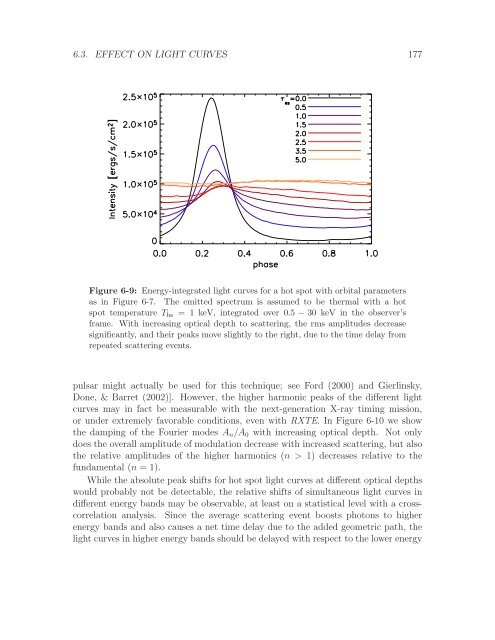Radiation Transport Around Kerr Black Holes Jeremy David ...
Radiation Transport Around Kerr Black Holes Jeremy David ...
Radiation Transport Around Kerr Black Holes Jeremy David ...
Create successful ePaper yourself
Turn your PDF publications into a flip-book with our unique Google optimized e-Paper software.
6.3. EFFECT ON LIGHT CURVES 177<br />
Figure 6-9: Energy-integrated light curves for a hot spot with orbital parameters<br />
as in Figure 6-7. The emitted spectrum is assumed to be thermal with a hot<br />
spot temperature T hs = 1 keV, integrated over 0.5 − 30 keV in the observer’s<br />
frame. With increasing optical depth to scattering, the rms amplitudes decrease<br />
significantly, and their peaks move slightly to the right, due to the time delay from<br />
repeated scattering events.<br />
pulsar might actually be used for this technique; see Ford (2000) and Gierlinsky,<br />
Done, & Barret (2002)]. However, the higher harmonic peaks of the different light<br />
curves may in fact be measurable with the next-generation X-ray timing mission,<br />
or under extremely favorable conditions, even with RXTE. In Figure 6-10 we show<br />
the damping of the Fourier modes A n /A 0 with increasing optical depth. Not only<br />
does the overall amplitude of modulation decrease with increased scattering, but also<br />
the relative amplitudes of the higher harmonics (n > 1) decreases relative to the<br />
fundamental (n = 1).<br />
While the absolute peak shifts for hot spot light curves at different optical depths<br />
would probably not be detectable, the relative shifts of simultaneous light curves in<br />
different energy bands may be observable, at least on a statistical level with a crosscorrelation<br />
analysis. Since the average scattering event boosts photons to higher<br />
energy bands and also causes a net time delay due to the added geometric path, the<br />
light curves in higher energy bands should be delayed with respect to the lower energy
















